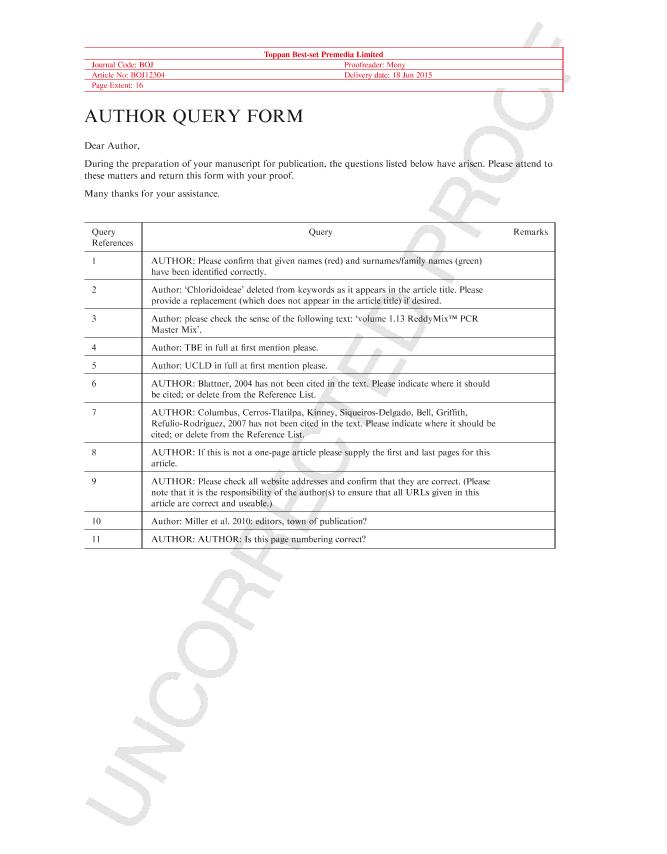Mostrar el registro sencillo del ítem
dc.contributor.author
Amarilla, Leonardo

dc.contributor.author
Chiapella, Jorge Oscar

dc.contributor.author
Sosa, Victoria
dc.contributor.author
Moreno, Natalia Cecilia

dc.contributor.author
Anton, Ana Maria Ramona

dc.date.available
2018-04-10T17:27:12Z
dc.date.issued
2015-06
dc.identifier.citation
Amarilla, Leonardo; Chiapella, Jorge Oscar; Sosa, Victoria; Moreno, Natalia Cecilia; Anton, Ana Maria Ramona; A tale of North and South America: time and mode of dispersal of the amphitropical genus Munroa (Poaceae, Chloridoideae); Oxford University Press; Botanical Journal of The Linnean Society; 179; 1; 6-2015; 110-125
dc.identifier.issn
0024-4074
dc.identifier.uri
http://hdl.handle.net/11336/41536
dc.description.abstract
Plant disjunctions have provided some of the most intriguing distribution patterns historically addressed by biogeographers. We evaluated the three hypotheses that have been postulated to explain these patterns [vicariance, stepping-stone dispersal and long-distance dispersal (LDD)] using Munroa, an American genus of grasses with six species and a disjunct distribution between the desert regions of North and South America. Ages of clades, cytology and ancestral characters and areas of distribution were investigated in order to establish relationships among species, determine the time of divergence of the genus and its main lineages and understand further the biogeographic and evolutionary history of this genus. Bayesian inference recovered the North American M. pulchella as sister species to the rest. Molecular dating and ancestral area analyses suggest that Munroa originated in North America in the late Miocene-Pliocene (7.2; 8.2?6.5 Mya). Based on these results we postulate that two dispersal events modeled the current distribution patterns of Munroa; the first from North to South America (7.2; 8.2?6.5 Mya ago) and the second (1.8; 2?0.8 Mya ago) from South to North America. Arid conditions of the late Miocene-Pliocene in the Neogene and Quaternary climatic oscillations in North America and South America were probably advantageous for establishment of populations of Munroa. We did not find any relationship between ploidy and dispersal events and our ancestral character analyses suggest that shifts associated with dispersal and seedling establishment, such as habit, reproductive system, disarticulation of rachilla and shape and texture of the glume, have been important in these species reaching new areas.
dc.format
application/pdf
dc.language.iso
eng
dc.publisher
Oxford University Press

dc.rights
info:eu-repo/semantics/openAccess
dc.rights.uri
https://creativecommons.org/licenses/by-nc-sa/2.5/ar/
dc.subject
American Arid Land
dc.subject
Amphitropical Disjunction
dc.subject
Chloridoideae
dc.subject
Historical Biogeography
dc.subject
Long-Distance Dispersal (Ldd)
dc.subject
Molecular Phylogeny
dc.subject
Munroa
dc.subject
Stepping-Stone Dispersal
dc.subject
Vicariance
dc.subject.classification
Otras Ciencias Biológicas

dc.subject.classification
Ciencias Biológicas

dc.subject.classification
CIENCIAS NATURALES Y EXACTAS

dc.title
A tale of North and South America: time and mode of dispersal of the amphitropical genus Munroa (Poaceae, Chloridoideae)
dc.type
info:eu-repo/semantics/article
dc.type
info:ar-repo/semantics/artículo
dc.type
info:eu-repo/semantics/publishedVersion
dc.date.updated
2018-04-10T14:17:54Z
dc.journal.volume
179
dc.journal.number
1
dc.journal.pagination
110-125
dc.journal.pais
Reino Unido

dc.journal.ciudad
Oxford
dc.description.fil
Fil: Amarilla, Leonardo. Consejo Nacional de Investigaciones Científicas y Técnicas. Centro Científico Tecnológico Conicet - Córdoba. Instituto Multidisciplinario de Biología Vegetal. Universidad Nacional de Córdoba. Facultad de Ciencias Exactas Físicas y Naturales. Instituto Multidisciplinario de Biología Vegetal; Argentina
dc.description.fil
Fil: Chiapella, Jorge Oscar. Consejo Nacional de Investigaciones Científicas y Técnicas. Centro Científico Tecnológico Conicet - Córdoba. Instituto Multidisciplinario de Biología Vegetal. Universidad Nacional de Córdoba. Facultad de Ciencias Exactas Físicas y Naturales. Instituto Multidisciplinario de Biología Vegetal; Argentina
dc.description.fil
Fil: Sosa, Victoria. Consejo Nacional de Ciencia y Tecnología. Instituto de Ecología; México
dc.description.fil
Fil: Moreno, Natalia Cecilia. Consejo Nacional de Investigaciones Científicas y Técnicas. Centro Científico Tecnológico Conicet - Córdoba. Instituto Multidisciplinario de Biología Vegetal. Universidad Nacional de Córdoba. Facultad de Ciencias Exactas Físicas y Naturales. Instituto Multidisciplinario de Biología Vegetal; Argentina
dc.description.fil
Fil: Anton, Ana Maria Ramona. Consejo Nacional de Investigaciones Científicas y Técnicas. Centro Científico Tecnológico Conicet - Córdoba. Instituto Multidisciplinario de Biología Vegetal. Universidad Nacional de Córdoba. Facultad de Ciencias Exactas Físicas y Naturales. Instituto Multidisciplinario de Biología Vegetal; Argentina
dc.journal.title
Botanical Journal of The Linnean Society

dc.relation.alternativeid
info:eu-repo/semantics/altIdentifier/doi/http://dx.doi.org/10.1111/boj.12304
dc.relation.alternativeid
info:eu-repo/semantics/altIdentifier/url/https://onlinelibrary.wiley.com/doi/abs/10.1111/boj.12304
dc.relation.alternativeid
info:eu-repo/semantics/altIdentifier/url/https://academic.oup.com/botlinnean/article/179/1/110/2416530
Archivos asociados
